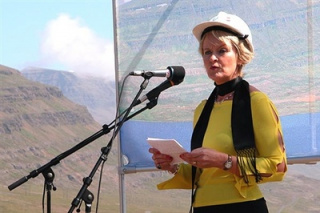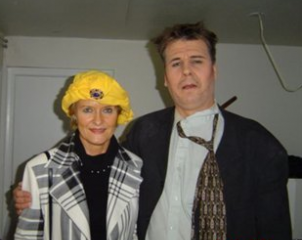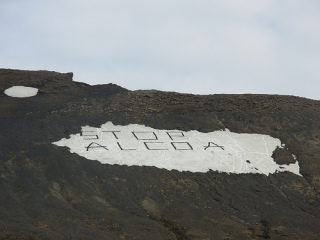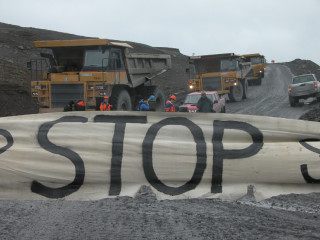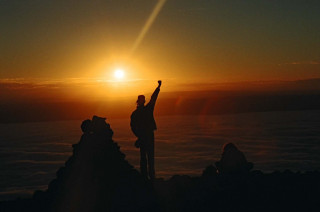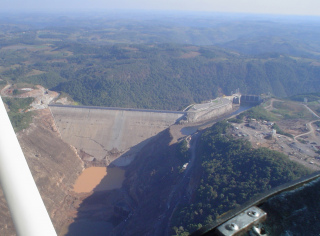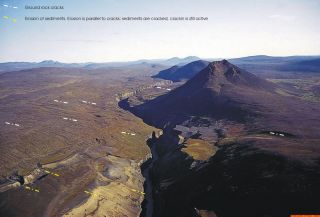News
Sep 04 2006
ALCOA, Economic Collapse, Economics, Impregilo, Kárahnjúkar, Landsvirkjun
The Iceland Nature Conservation Association claims that the National Power Company will incur a loss of between ISK 20-30 billion through its investment in the Kárahnjúkavirkjun dam project in east Iceland. The calculations are based on figures released by the National Power Company in a reviewed profitability assessment for the dam. Morgunbladid online reports.
In a press release, the Iceland Nature Conservation Association states that it has often “criticized the negative rate of return of the Kárahnjúkavirkjun dam and in particular how low the requirements by the National Power Company (the owners) are for its investment to return a profit”.
The Iceland Nature Conservation Association bases its calculations on the Weighted Average Cost of Capital being 8-9 percent, as is considered “normal and natural based on market criteria.” Read More
Sep 01 2006
ALCOA, Corruption, Kárahnjúkar, Landsvirkjun, Laws, Repression
Former Minister of Commerce and Industry Valgerdur Sverrisdóttir refused to meet Left-Green Party leader Steingrímur J. Sigfússon on the Kastljós news program on Wednesday evening, to discuss why she had failed to disclose details of a report concerning the Kárahnjúkavirkjun dam project to parliament. This was revealed in a letter by the director of the Icelandic National Broadcasting Corporation (RÚV), which broadcasts the program. Previously Sigfússon had publicly criticized the fact.
Read More
Aug 28 2006
ALCOA, Corruption, Impregilo, Kárahnjúkar, Landsvirkjun, Laws, Repression
Árni Finnsson, chairman of the Iceland Nature Conservation Association, accuses former Minister of Industry and Commerce Valgerdur Sverrisdóttir of corruption, for failing to reveal details of a report showing that the area on which the Kárahnjúkavirkjun dam is being built has active faults in the earth. This was reported by all the main media this weekend and is reported by RÚV online today.
Geophysicist Grímur Björnsson recently revealed on television news programme Kastljós that a report he had prepared, criticizing the placement of the Kárahnjúkar dam, had been stamped as confidential by his superior at the time. Minister of Industry Sverrisdóttir had subsequently failed to reveal the details of the report to parliament, as she was obliged to do.
Sverrisdóttir rejects all accusations, claiming the current controversy is a last-ditch effort on behalf of the opposition to delay the flooding of the Hálsalón reservoir. The flooding of the reservoir, which is set to take place at the end of September, will submerge a large section of the Icelandic highlands. Read More
Aug 24 2006
Actions, ALCOA, Kárahnjúkar, Laws, Saving Iceland
Aluminum giant Alcoa, which is behind the construction of a new smelter in Reydarfjördur, east Iceland, has pressed charges against protesters who illegally entered the building site yesterday, Fréttabladid reports today. Work on the site was halted for approximately eight hours as protesters climbed building cranes and chained themselves to heavy machinery. Alcoa has not ruled out the possibility of demanding compensation from the activists as a result of their actions.
Read More
Aug 24 2006
4 Comments
Actions, ALCOA, Bechtel, Ecology, Impregilo, Landsvirkjun, Saving Iceland
No matter the environmental and social cost, no matter the ever increasing protests from the Icelandic and international communities and the intensifying warnings fom the scientific sector, the Icelandic government is hellbent on going ahead with its plan to inundate the projected Hálslón reservoir at Kárahnjúkar between 15-30 September.
They must be stopped!
Wherever you are in the world it is likely that there will be a target for you to make your protest felt. Icelandic embassies, consulates or the companies involved in the project, ALCOA, Bechtel, Impregilo… See a list of the companies involved on “The Nature Killers” on our website.
ALCOA worldwide
Icelandic diplomatic missions
TAKE ACTION AGAINST THE DESTRUCTION OF EUROPE’S LAST GREAT WILDERNESS!
ALCOA OUT OF ICELAND!
Aug 20 2006
Actions, ALCOA, Democracy deficit, Ecology, Greenwash, Impregilo, Kárahnjúkar, Landsvirkjun, Ólafur Páll Sigurdsson, Pollution, Repression, Saving Iceland
This summer’s protest camp is disbanding but the fight must go on. Icelandic nature is running out of time, as it is being relentlessly destroyed by those whose wealth and power comes from the exploitation of people and the environment.
The campaign against heavy industry is making progress and it seems that there are more and more Icelanders who are no longer willing to stand by and watch as Iceland is turned into an industrial wasteland (like much of Europe already is). Some of us will soon go back to the 18 different countries which we came from; countries where industrialisation has left us with pollution, illness and disease. We must cross borders to support each other, as these corporations see borders only in terms of how they can be used to divide people. Meanwhile they take our land and profit from our work.
Most importantly, we hope that we have inspired and encouraged others to take action against the destruction of nature in whatever way they are able. People have to realise the importance and fragility of the wilderness before it is (soon) too late. There is no infinite wilderness to be exploited, nor is there infinite time to wait around for a miracle to help us.
We have enjoyed an immense level of support and co-operation from a wide range of people in Iceland. Thank-you to all of the amazing people who have helped so far in the struggle against this horrific destruction of nature which only benefits the rich executives of multinational corporations.
Aug 18 2006
ALCOA, Corruption, Ecology, Geology, Impregilo, Kárahnjúkar, Landsvirkjun, Laws, Repression
Leader of the opposition in Iceland’s parliament, Ingibjörg Sólrún Gísladóttir, has demanded a new risk assessment for the area on which the Kárahnjúkavirkjun dam in east Iceland is being built. The dam is being constructed to supply the Alcoa aluminum smelter being raised in Reydarfjördur, east Iceland, with power. This is reported in all the main media today.
Álfheidur Ingadóttir, who has a seat on the board of the National Power Company, told RÚV yesterday that geological research carried out prior to the start of the Kárahnjúkavirkjun dam project had been inadequate. Sigurdur Arnalds, spokesman for the project, says that despite it having been proven that geological tremors in the area are more likely than previously thought, it had been ensured at the preparation stage that nothing would go wrong despite seismic activity.
Read More
Aug 10 2006
Actions, ALCOA, Bechtel, Kárahnjúkar, Saving Iceland
11 August 2006
The protest camp has relocated to the farm Kollaleira, in Reyðarfjörður. This is the fjord where war profiters Bechtel are building the ALCOA aluminimum smelter.
To join us see the ‘Join the fight’ section for updated info and contact number.
THE FIGHT AGAINST THE DESTROYERS OF NATURE GOES ON!!!
Aug 09 2006
Actions, ALCOA, Impregilo, Kárahnjúkar, Landsvirkjun, Laws, Repression, Saving Iceland
The Icelandic police is currently under fire for alleged harsh treatment of protesters near the Kárahnjúkavirkjun dam project in eastern Iceland. Protests have been ongoing since early July and have for the most part been peaceful. Since the beginning of August, reports have surfaced of more severe actions than before on the parts of protesters, including blocking routes for the movement of heavy machinery. Protestors claim that police have responded with unwarranted harshness. Last weekend the group, which counts some 50 individuals of all nationalities, was broken up by police and protestors made to leave the site where they had set up camp.
Meanwhile, the Icelandic National Broadcasting Service (RÚV) showed footage on yesterday evening’s national news, where the Head of Police in Egilsstadir, east Iceland, shoves a cameraman who was filming protesters and police on police premises in Egilsstadir. The police officer later admitted to having been out of line. The same news hour showed an interview with Álfheidur Ingadóttir, who sits on the board of the National Power Company (Landsvirkjun), in which she voiced her anger at having been kept under surveillance by police authorities while hiking through the Kárahnjúkar area recently. The area, which is set to go under water this September when a reservoir is created to feed the Kárahnjúkavirkjun dam, has been visited by a vast number of tourists this summer. Read More
Aug 09 2006
Actions, ALCOA, Bechtel, Impregilo, Kárahnjúkar, Landsvirkjun, Laws, Repression, Saving Iceland
Reykjavik Grapevine
As usual Reykjavik Grapevine has regrettable problems with getting some of their facts right, but still worth a read.[Ed.]
A series of dubious tactics by law enforcement officials in the area around the Kárahnjukar dam protests have left protestors and conservationists throughout Iceland screaming “foul”. Read More
